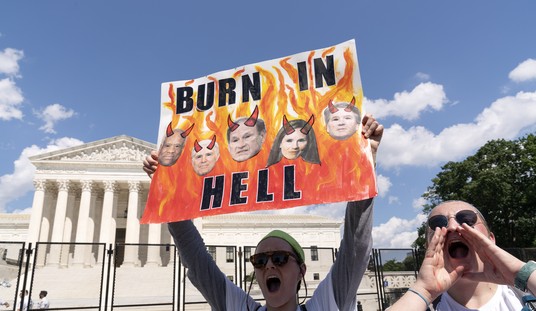The Associated Press, the New York Times, Reuters, and other news organizations — not to mention political bloggers from both the left and right –were buzzing Wednesday morning over an online report issued by The Center for Public Integrity (CPI) and a related organization, The Fund for Independence in Journalism (FIJ).
The report, entitled Iraq: The War Card-Orchestrated Deception on the Path to War, claims that President Bush and top administration officials were complicit in issuing hundreds of false statements regarding the threat posed by Saddam Hussein’s Iraq after the 9/11/2001 terror attacks in a run-up to the invasion of Iraq in March of 2003.
An overview published Tuesday evening stated:
President George W. Bush and seven of his administration’s top officials, including Vice President Dick Cheney, National Security Adviser Condoleezza Rice, and Defense Secretary Donald Rumsfeld, made at least 935 false statements in the two years following September 11, 2001, about the national security threat posed by Saddam Hussein’s Iraq. Nearly five years after the U.S. invasion of Iraq, an exhaustive examination of the record shows that the statements were part of an orchestrated campaign that effectively galvanized public opinion and, in the process, led the nation to war under decidedly false pretenses.
On at least 532 separate occasions (in speeches, briefings, interviews, testimony, and the like), Bush and these three key officials, along with Secretary of State Colin Powell, Deputy Defense Secretary Paul Wolfowitz, and White House press secretaries Ari Fleischer and Scott McClellan, stated unequivocally that Iraq had weapons of mass destruction (or was trying to produce or obtain them), links to Al Qaeda, or both. This concerted effort was the underpinning of the Bush administration’s case for war.
And later:
In short, the Bush administration led the nation to war on the basis of erroneous information that it methodically propagated and that culminated in military action against Iraq on March 19, 2003. Not surprisingly, the officials with the most opportunities to make speeches, grant media interviews, and otherwise frame the public debate also made the most false statements, according to this first-ever analysis of the entire body of prewar rhetoric.
Critics in the conservative blogosphere were quick to note that CPI and FIJ were heavily funded by left-leaning foundations and individuals, and therefore may be acting in partisan interests.
Supporters of the report in the left-wing blogosphere were quick to trot out variations of the “Bush lied, people died” meme, stating that the study only reinforced what they’ve believed for several years.
Beyond the partisanship lies an essential question: is the two-year study based upon a legitimate, objective methodology?
The Methodology page of the report’s web site states:
Over the past two and a half years, researchers at the Fund for Independence in Journalism have sought to document every public statement made by eight top Bush administration officials from September 11, 2001, to September 11, 2003, regarding (1) Iraq’s possession of weapons of mass destruction and (2) Iraq’s links to Al Qaeda. Although both had been frequently cited as rationales for the U.S. war in Iraq, by 2005 it was known that these assertions had not, in fact, been true.
The centerpiece of this project is an exhaustive, searchable, and robustly indexed database of all public statements on the two topics by President George W. Bush, Vice President Dick Cheney, Secretary of State Colin Powell, National Security Adviser Condoleezza Rice, Defense Secretary Donald Rumsfeld, Deputy Defense Secretary Paul Wolfowitz, and White House Press Secretaries Ari Fleischer and Scott McClellan. These statements were painstakingly collected from the websites of the White House, State Department, and Defense Department as well as from transcripts of interviews and briefings, texts of speeches and testimony, prepared statements, and the like.
Also included are statements in the same two categories that appeared in major newspapers and on television programs, were part of public statements by other officials, or were contained in government studies or reports, books, and the like from September 11, 2001, to December 31, 2007. Secondary material from reports and books was included in the two-year database only in cases where specific dates were available. Other noteworthy material was included for context and completeness.
As a general rule, only the relevant excerpts of public statements have been included in the database; deleted material is marked “[text omitted].” (In a case of a lengthy press conference in which Iraq is mentioned only briefly, for example, only the relevant passage is included.) Where deleting text might have rendered the remaining material misleading or difficult to understand, longer passages were left intact. And in some cases public pronouncements of Bush administration officials that did not include direct statements were included if they provided useful context.
As for working definitions, CPI and FIJ chose the following:
“False Statements” – Definitions
In press briefings, interviews, and other question-and-answer venues, each answer was categorized for purposes of this study as a distinct statement. In speeches or briefings, only when one statement clearly ends was the next statement considered, and then only if a “buffer” of at least 50 words separated the statements.
Direct false statements. False statements by the eight Bush administration officials were counted as “direct”-and included in the total count of false statements-when they specifically linked Iraq to Al Qaeda or referenced Iraq’s contemporaneous possession, possible possession, or efforts to obtain weapons of mass destruction (chemical, biological, or nuclear weapons). In addition, any use of the verb “disarm” was categorized as a direct statement because of the literal meaning of the word. (Example: “Saddam Hussein has got a choice, and that is, he can disarm.”) These false statements can be found within the passages that are highlighted in yellow in the project database.
Indirect false statements. Statements were classified as “indirect” if they did not specifically link Iraq to Al Qaeda but alleged, for example, that Iraq supported or sponsored terrorism or terrorist organizations, or if they referred to Iraq’s former possession of weapons of mass destruction or used such general phrases, for example, as “dangerous weapons.” These indirect false statements are not included in the total count of 935.
The FIJ and CPI researchers may have purposefully compromised the integrity of the report by creating the definition “false statements” and sub-categories “direct false statements” and “indirect false statements,” which seem to be predicated upon the ultimate veracity of the statements after several years of hindsight and study.
They did not, as it would seem to be fair, base the study upon what was known at the time in the 2001-2003 run-up to the war in Iraq. The premise for the report seems to be reflected in the title of the report, that there was orchestrated deception on behalf of senior Bush Administration officials, not statements made upon inaccurate or misleading intelligence information as events unfolded.
Comparative framing analysis suggests that this report purposefully constructed a point of view that encouraged readers to interpret the “facts” in a particular manner.
Dr. Jim A. Kuypers, an assistant professor of Political Communication and Rhetoric & Public Address at Virginia Tech University, is an expert in comparative framing analysis and is author of %%AMAZON=074253653X Bush’s War: Media Bias and Justifications for War in a Terrorist Age%% and A Comparative Framing Analysis of Embedded and Behind-the-Lines Reporting on the 2003 Iraq War, published in Qualitative Research Reports in Communication, Volume 6, Issue 1 October 2005.
Asked by PJM to comment upon the CPI/FIJ study’s stated methodology and definitions, Dr Kuypers wrote that the study was compromised by biases and prejudiced assumptions from the outset:
The study does not appear to take into account the context of the time the original statements were uttered. Instead, it seems to start with an assumption that the administration deliberately mislead America to war. If the study had started with the assumption that the Bush administration and the intelligence community had misinterpreted intelligence reports, then these statements CPI collected could be interpreted in a very different manner. The study also fails to mention that a large majority in Congress, including top ranking Democrats, believed the intelligence assessments, and were briefed in more detail than the president about the situation. They still supported action against Hussein. It would be interesting to see the study enlarged to include statements made by those Democrats who voted for military action.
Their “methodology” is short on detail, but I infer that they (who, how many?) actually performed a sort of “content analysis” using very broad categories: Direct false statements — “when [the administration] specifically linked Iraq to Al Qaeda or referenced Iraq’s contemporaneous possession, possible possession, or efforts to obtain weapons of mass destruction (chemical, biological, or nuclear weapons). In addition, any use of the verb ‘disarm’ was categorized as a direct statement because of the literal meaning of the word.” The other category, Indirect false statements–“Statements were classified as “indirect” if they did not specifically link Iraq to Al Qaeda but alleged, for example, that Iraq supported or sponsored terrorism or terrorist organizations, or if they referred to Iraq’s former possession of weapons of mass destruction or used such general phrases, for example, as “dangerous weapons.” These indirect false statements are not included in the total count of 935.”
Essentially, then, someone (we don’t know who or how many) read through transcripts and speeches looking for quotes that would in anyway support the a priori belief that the Bush administration misled Americans.
On the one hand, this looks like a sloppy study; on the other, the results do fall within the categories above, it is just the “spin” or interpretation put on them that causes one to wonder about motivation.
The “study” is based upon spin, false pretenses, cherry-picked statements, and artificial limitations to the breath of scope which excludes similar conclusions reached by the Clinton administration and Democrats and Republicans alike in both houses of Congress, and assessments from foreign governments.
The study’s “Key False Statements” page is as much an indictment of the lack of integrity from The Center for Public Integrity, and lack of independence from The Fund for Independence in Journalism, as it is an assault on the Bush Administration.
The CPI’s “Key False Statements” report stated, for example:
In a speech on August 26, 2002, Vice President Dick Cheney flatly asserted that “there is no doubt that Saddam Hussein now has weapons of mass destruction.”
Central Intelligence Agency Director George Tenet later wrote that Cheney’s statement “went well beyond what our own analysis could support.” Tenet was not alone within the CIA. As one of his top deputies later told journalist Ron Suskind: “Our reaction was, ‘Where is he getting this stuff from? Does he have a source of information that we don’t know about?'”
As Dr. Kuyper notes in response, “Perhaps the question to ask is why did the administration believe so strongly that Iraq had WMDs? Instead, CPI contextualizes by paraphrase and citing an anonymous source. Alternatively, Cheney’s statement could have been framed as running congruent to many members of Congress and British Intelligence.”
Again, another erroneous “Key False Statement” from CPI’s study:
In his State of the Union address on January 28, 2003, President Bush said: “The British government has learned that Saddam Hussein recently sought significant quantities of uranium from Africa.”
But as early as March 2002, there was uncertainty within the intelligence community regarding the sale of uranium to Iraq. That month, the State Department’s Bureau of Intelligence and Research published an intelligence assessment titled, “Niger: Sale of Uranium to Iraq Is Unlikely.” In July 2002, the Energy Department concluded that there was “no information indicating that any of the uranium shipments arrived in Iraq” and suggested that the “amount of uranium specified far exceeds what Iraq would need even for a robust nuclear weapons program.” In August 2002, the Central Intelligence Agency made no mention of the Iraq-Niger connection in a paper on Iraq’s WMD capabilities.
Note that President Bush said that Hussein sought uranium, not that a transaction or transfer had been completed. Seeking to complete a task and actually completing it are two entirely separate things. This statement by the President is in no way contradicted by the State Department’s Bureau of Intelligence and Research assessment, nor the Energy Department’s conclusion that no shipments arrived in Iraq. This simply was not a false statement–but it was yet more evidence of misleading allegations from the CPI/FIJ authors.
Other claims made in the “Key False Statements” page are dubious in nature, presenting examples of bad intelligence, selective interpretations, and conflicting analyses that were encountered as events happened as willful deceptions by administration officials. The CPI/FIJ authors compiled their “research” through a lens of hindsight none of the actors had at the time, artificially framed the statements as either “direct false statements” or “indirect false statements,” and pushed political advocacy as legitimate research.
In an ironic twist, the greatest dishonesty captured in the CPI/FIJ study seems to be traced back to its authors.
Bob Owens blogs at Confederate Yankee.









Join the conversation as a VIP Member